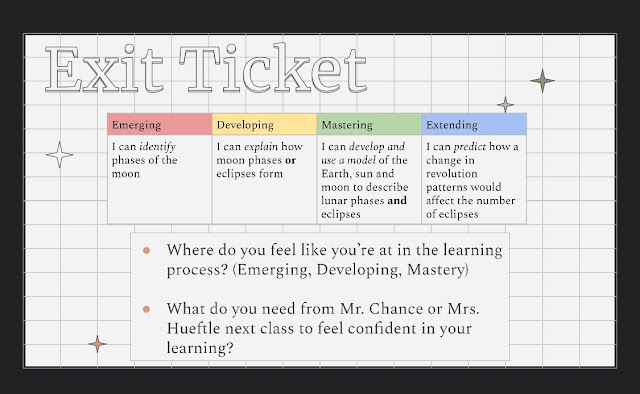
Your Ticket to More Effective Lessons
Throughout my instruction to grow to be a teacher, I was immersed in the work of Madeline Hunter when it arrived to lesson prepare design. Her Educational Theory into Exercise (ITIP) model aided me identify the strategies I would use on a daily basis to assistance my students discover. These integrated the anticipatory set (hook), reviewing prior learning, checking for comprehending, varieties of practice, and closure. Each lesson had these things and I often received optimistic responses from administrators on these when they observed me. Closure is some thing I was very very pleased of and I constantly ended classes with some sort of paper exit ticket. I shared the next in Disruptive Considering:
Whilst the opening moments with college students are vital, so are the remaining minutes. Feel about this for a next. What’s the point of an aim or studying focus on, whether or not mentioned, on the board, or students having the chance to discover for by themselves, if there is no opportunity at the stop of the lesson to identify if it was realized? Understanding boosts when classes are concluded in a fashion that can help college students arrange and don’t forget the place of the lesson.
At the time, this design was both a sensible and helpful indicates for planning direct instruction and was readily embraced as this was the key method employed in classrooms. It streamlined tactics in an successful way that could be replicated day in and working day out. Herein lies the principal downside of ITIP. It was a one particular-sizing-matches-all approach centered on the trainer producing all the conclusions from an educational standpoint at the expense of creating qualified learners who can feel.
Like numerous issues in education and learning, features of ITIP nevertheless have benefit depending on how they are applied. Closure is however vital, in my viewpoint, as a suggests to ascertain lesson usefulness and provide as a catalyst for reflective development. Exit tickets, when produced effectively, depict a audio system to be executed at the conclusion of a lesson. In uncomplicated terms, these are ungraded formative assessments that assess what college students discovered through the system of the lesson. The details from then can be utilized to recognize the adhering to:
- Degree of mastery
- Spots of difficulty
- Prospects to reteach
- Gaps in learner understanding
The data gleaned from them presents the trainer with further perception as to how the lesson went and what can be completed to enhance it in the potential. A new stop by to Quest Academy Junior High University, exactly where I began longitudinal function on personalized competency-based mostly studying (PCBL), bought me pondering far more deeply about this system. The principal, Nicki Slaugh, is a trailblazer in this space and I am fortunate enough to be furnishing coaching support to her personnel to just take them to the upcoming degree. Whilst traveling to school rooms with Nicki, we noticed a slew of superb techniques in motion. Even so, I was exceptionally impressed with the exit ticket created by science trainer Melanie Hueftle, which you can see under.
Not only does this satisfy the standards for a perfectly-created exit ticket, but it also goes substantially extra profound and serves as a much more effective reflective software for the two the teacher and the pupil. As documented by John Hattie, self-reported grades/pupil anticipations are a person of the most powerful approaches out there (outcome sizing = 1.44). The exit ticket places the “personal” in individualized as each and every learner decides where by they are in relation to the mastering concentrate on. I also enjoy the truth that they can advocate for guidance from not 1 but two diverse lecturers. Figuring out Nicki and her extraordinary team, what you see above is most possible the norm in a lot of Quest Academy school rooms.
Test This
- To start with, if you are presently utilizing exit tickets or some other suggests of lesson closure, that is wonderful, but take a moment to reflect on whether or not they are delivering the style of substantive info I’ve outlined here, or if they’re basically creating your classes a bit lengthier. Think about if your use of closure components may be tweaked to offer higher value to you and to your college students. As you solution long run classes, zero in on what these responsibilities are telling you about college student learning—on an unique foundation and as a whole team. Are you observing any designs? How might you change your instruction to offer much more aim exactly where each individual university student requirements it?
- If exit tickets are new to you, that’s wonderful, too—what an opportunity! To start with, take into consideration what feed-back would be most useful to you and your learners. The instance I provided below is just one particular, but Google “exit tickets” and you’ll see a selection of examples. Really do not reinvent the wheel. Find one that fits your wants and modify it to make it yours. What lesson this 7 days is a organic suit for an exit ticket? Pick out a single, establish your ticket, and just try it with your class. Then reflect on the information and facts it provides—how does this align with your anticipations all-around what you want your learners to have an understanding of? What actions will you just take to regulate your instruction? Remember, info is wonderful, but it is what we do with it that issues.
My hope is that these straightforward ideas assist you boost what you are already undertaking or offer the usually means to build powerful exit tickets that not only serve as closure, but established the phase for your upcoming lesson.


